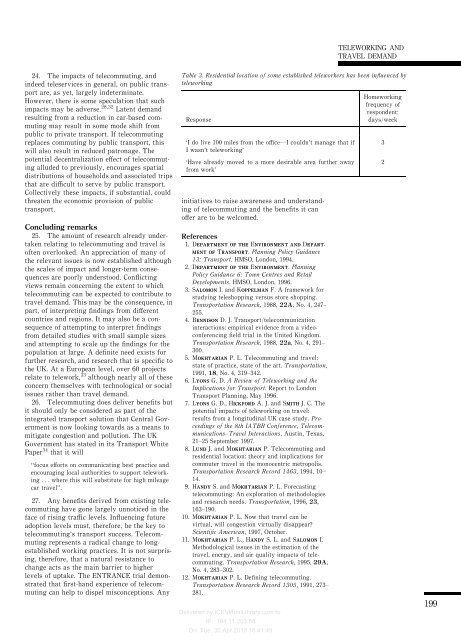Lyons, G. (1998) An assessment of teleworking as a practice for ...
Lyons, G. (1998) An assessment of teleworking as a practice for ...
Lyons, G. (1998) An assessment of teleworking as a practice for ...
You also want an ePaper? Increase the reach of your titles
YUMPU automatically turns print PDFs into web optimized ePapers that Google loves.
TELEWORKING AND<br />
TRAVEL DEMAND<br />
24. The impacts <strong>of</strong> telecommuting, and<br />
indeed teleservices in general, on public transport<br />
are, <strong>as</strong> yet, largely indeterminate.<br />
However, there is some speculation that such<br />
impacts may be adverse. 28,32 Latent demand<br />
resulting from a reduction in car-b<strong>as</strong>ed commuting<br />
may result in some mode shift from<br />
public to private transport. If telecommuting<br />
replaces commuting by public transport, this<br />
will also result in reduced patronage. The<br />
potential decentralization e€ect <strong>of</strong> telecommuting<br />
alluded to previously, encourages spatial<br />
distributions <strong>of</strong> households and <strong>as</strong>sociated trips<br />
that are dicult to serve by public transport.<br />
Collectively these impacts, if substantial, could<br />
threaten the economic provision <strong>of</strong> public<br />
transport.<br />
Concluding remarks<br />
25. The amount <strong>of</strong> research already undertaken<br />
relating to telecommuting and travel is<br />
<strong>of</strong>ten overlooked. <strong>An</strong> appreciation <strong>of</strong> many <strong>of</strong><br />
the relevant issues is now established although<br />
the scales <strong>of</strong> impact and longer-term consequences<br />
are poorly understood. Con¯icting<br />
views remain concerning the extent to which<br />
telecommuting can be expected to contribute to<br />
travel demand. This may be the consequence, in<br />
part, <strong>of</strong> interpreting ®ndings from di€erent<br />
countries and regions. It may also be a consequence<br />
<strong>of</strong> attempting to interpret ®ndings<br />
from detailed studies with small sample sizes<br />
and attempting to scale up the ®ndings <strong>for</strong> the<br />
population at large. A de®nite need exists <strong>for</strong><br />
further research, and research that is speci®c to<br />
the UK. At a European level, over 60 projects<br />
relate to telework, 33 although nearly all <strong>of</strong> these<br />
concern themselves with technological or social<br />
issues rather than travel demand.<br />
26. Telecommuting does deliver bene®ts but<br />
it should only be considered <strong>as</strong> part <strong>of</strong> the<br />
integrated transport solution that Central Government<br />
is now looking towards <strong>as</strong> a means to<br />
mitigate congestion and pollution. The UK<br />
Government h<strong>as</strong> stated in its Transport White<br />
Paper 34 that it will<br />
``focus e€orts on communicating best <strong>practice</strong> and<br />
encouraging local authorities to support <strong>teleworking</strong><br />
. . . where this will substitute <strong>for</strong> high mileage<br />
car travel''.<br />
27. <strong>An</strong>y bene®ts derived from existing telecommuting<br />
have gone largely unnoticed in the<br />
face <strong>of</strong> rising trac levels. In¯uencing future<br />
adoption levels must, there<strong>for</strong>e, be the key to<br />
telecommuting's transport success. Telecommuting<br />
represents a radical change to longestablished<br />
working <strong>practice</strong>s. It is not surprising,<br />
there<strong>for</strong>e, that a natural resistance to<br />
change acts <strong>as</strong> the main barrier to higher<br />
levels <strong>of</strong> uptake. The ENTRANCE trial demonstrated<br />
that ®rst-hand experience <strong>of</strong> telecommuting<br />
can help to dispel misconceptions. <strong>An</strong>y<br />
Table 3. Residential location <strong>of</strong> some established teleworkers h<strong>as</strong> been in¯uenced by<br />
<strong>teleworking</strong><br />
Response<br />
`I do live 100 miles from the oceÐI couldn't manage that if<br />
I w<strong>as</strong>n't <strong>teleworking</strong>'<br />
`Have already moved to a more desirable area further away<br />
from work'<br />
initiatives to raise awareness and understanding<br />
<strong>of</strong> telecommuting and the bene®ts it can<br />
o€er are to be welcomed.<br />
References<br />
1. DEPARTMENT OF THE ENVIRONMENT AND DEPART-<br />
MENT OF TRANSPORT<br />
RANSPORT. Planning Policy Guidance<br />
13: Transport. HMSO, London, 1994.<br />
2. DEPARTMENT OF THE ENVIRONMENT. Planning<br />
Policy Guidance 6: Town Centres and Retail<br />
Developments. HMSO, London, 1996.<br />
3. SALOMON<br />
I. and KOPPELMAN<br />
F. A framework <strong>for</strong><br />
studying teleshopping versus store shopping.<br />
Transportation Research, 1988, 22A, No. 4, 247±<br />
255.<br />
4. BENNISON<br />
D. J. Transport/telecommunication<br />
interactions: empirical evidence from a videoconferencing<br />
®eld trial in the United Kingdom.<br />
Transportation Research, 1988, 22a, No. 4, 291±<br />
300.<br />
5. MOKHTARIAN<br />
P. L. Telecommuting and travel:<br />
state <strong>of</strong> <strong>practice</strong>, state <strong>of</strong> the art. Transportation,<br />
1991, 18, No. 4, 319±342.<br />
6. LYONS<br />
G. D. A Review <strong>of</strong> Teleworking and the<br />
Implications <strong>for</strong> Transport. Report to London<br />
Transport Planning, May 1996.<br />
7. LYONS<br />
G. D., HICKFORD<br />
A. J. and SMITH<br />
J. C. The<br />
potential impacts <strong>of</strong> <strong>teleworking</strong> on travel:<br />
results from a longitudinal UK c<strong>as</strong>e study. Proceedings<br />
<strong>of</strong> the 8th IATBR Conference, Telecommunications±Travel<br />
Interactions, Austin, Tex<strong>as</strong>,<br />
21±25 September 1997.<br />
8. LUND<br />
J. and MOKHTARIAN<br />
P. Telecommuting and<br />
residential location: theory and implications <strong>for</strong><br />
commuter travel in the monocentric metropolis.<br />
Transportation Research Record 1463, 1994, 10±<br />
14.<br />
9. HANDY<br />
S. and MOKHTARIAN<br />
P. L. Forec<strong>as</strong>ting<br />
telecommuting: <strong>An</strong> exploration <strong>of</strong> methodologies<br />
and research needs. Transportation, 1996, 23,<br />
163±190.<br />
10. MOKHTARIAN<br />
P. L. Now that travel can be<br />
virtual, will congestion virtually disappear?<br />
Scienti®c American, 1997, October.<br />
11. MOKHTARIAN<br />
P. L., HANDY<br />
S. L. and SALOMON<br />
I.<br />
Methodological issues in the estimation <strong>of</strong> the<br />
travel, energy, and air quality impacts <strong>of</strong> telecommuting.<br />
Transportation Research, 1995, 29A,<br />
No.4,283±302.<br />
12. MOKHTARIAN<br />
P. L. De®ning telecommuting.<br />
Transportation Research Record 1305, 1991, 273±<br />
281.<br />
Delivered by ICEVirtualLibrary.com to:<br />
IP: 164.11.203.58<br />
On: Tue, 30 Apr 2013 16:41:49<br />
Homeworking<br />
frequency <strong>of</strong><br />
respondent:<br />
days/week<br />
3<br />
2<br />
199
















